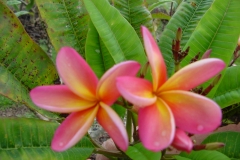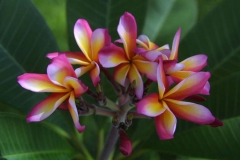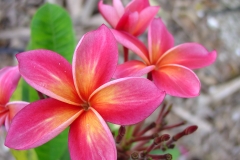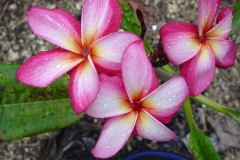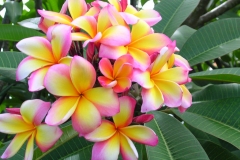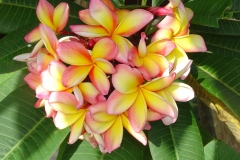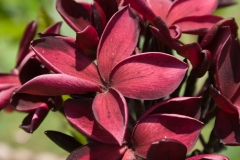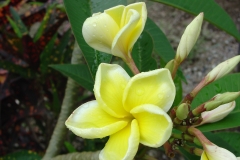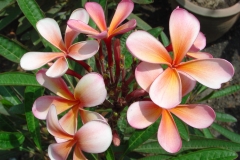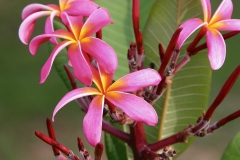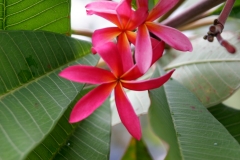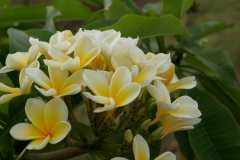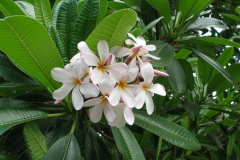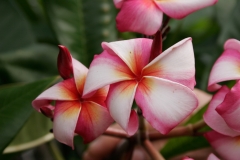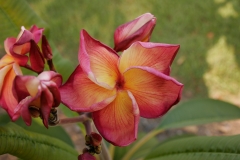How to Root Plumeria Cuttings
Propagation by cuttings is the most commonly used method to propagate plumeria. Normally plumeria cuttings are quite easy to root if done in the Spring and Summer. All plumeria cutting will root under perfect conditions, some take longer than others. Do your research so you are aware of the hard to root cultivars. Some hybrid plumeria can be more difficult to root.
The biggest mistakes made are over-watering and trying to root late in the growing season. For difficult to root plumeria cuttings you can use a grow or heat mat placed under the pots to encourage new root growth. Plumeria roots grow best when the root zone temperature is between 75 and 85 degrees.
Procedures for Rooting Plumeria Cuttings
Rooting cuttings in the soil is the best way to get strong roots
- Cuttings should generally consist of the current or past season’s growth. Avoid taking green cuttings, they are harder to root and avoid material with flower buds if possible. Remove any flowers and flower buds when preparing cuttings so the cutting’s energy can be used in producing new roots rather than flowers. Take cuttings from healthy, disease-free plants, preferably from the upper part of the plant. Select cuttings from a healthy plumeria.
- The fertility status of the parent plant can influence rooting. Avoid taking cuttings from plants that show symptoms of mineral nutrient deficiency. Conversely, plants that have been fertilized heavily, particularly with nitrogen, may not root well. The stock plant should not be under moisture stress. Cuttings from lateral shoots often root better than cuttings from terminal shoots.
- Early morning is the best time to take cuttings because the plant is fully turgid. It is important to keep the cuttings cool and moist until they are planted.
- While terminal parts of the stem are best, a long shoot can be divided into several cuttings. Depending on the Cultivar cuttings will generally range from 10 to 18 inches long. Use a sharp, thin-bladed pocket knife or sharp pruning shears. If necessary, dip the cutting tool in rubbing alcohol or a mixture of 1 part bleach to 9 parts water to prevent transmitting diseases from infected plant parts to healthy ones.
- Remove the leaves by cutting the leaf stem about 1/2″ from the branch before or right after you take the cutting. Leaves left on cuttings will cause the loss of valuable moisture. Breaking the leaves off can damage the cutting and allow the disease to enter the damaged leaf nodes.
- Treating cuttings with root-promoting compounds, (while the latex is still wet) can be a valuable tool in stimulating the rooting of some plumeria that might otherwise be difficult to root. Prevent possible contamination of the entire supply of rooting hormone by putting some in a separate container before treating cuttings. Any material that remains after treatment should be discarded and not returned to the original container. Be sure to tap the cuttings to remove excess hormone when using a powder formulation.
- Place the cutting out of the direct sun in a dry location. Allow the cut end of the cutting to dry until it is dry and firm. This takes 5 to 15 days depending on the weather. If the cut end becomes soft or rot starts, you will need to cut until all the dark coloration is gone. You can dip in a rooting hormone after a new cut is made. Before planting be sure the cutting is firm and looks healthy. If the cutting looks dehydrated or wrinkled you can soak for 4-6 hours in water. A bit of superthrive can be beneficial.
- The rooting medium should be sterile, low in fertility, and well-drained to provide sufficient aeration. It should also retain enough moisture so that watering does not have to be done too frequently. Materials commonly used is a mixture of one part peat and one part perlite (by volume). Vermiculite by itself is not recommended, because it compacts and tends to hold too much moisture. Media should be watered while being used.
- Insert the cuttings one-third their length or at least 3″ into the medium. Maintain the vertical orientation of the cutting (do not insert the cuttings upside down). Make sure the buds are pointed up. Space cuttings are just far enough apart to allow all leaves to receive sunlight. Water well after inserting the cuttings and lightly tamp the mix around the stem of the cutting to provide support. If needed you can brace the cutting with stakes make out of bamboo. The less movement the better. Avoid the direct sun until you see signs of leaves. After the first watering keep the medium dry until the cutting has rooted. If the cutting appears to be dried out or wrinkled, a light misting on a regular basis to keep the cutting hydrated.
- Rooting time varies with the type of cutting (tip or mid-cutting), the cultivar being rooted, and environmental conditions. Reds typically require more time than white or yellow plants. Early Spring to Mid Summer is a good time to root plumeria. Once rooted, they will have three or four normal size leaves and may be transferred to a larger pot and fertilized. Winter is not a good time due to plumeria going dormant.
- Newly rooted cuttings should not be transplanted directly into the landscape. Instead, transplant them into containers. Growing them to a larger size before transplanting to a permanent location will increase the chances of survival.
Rooting Plumeria cuttings in water
Although people have been rooting plumeria in water with some success, this is not the best way to root your plumeria. The roots that form in water are not the same as roots that form in the soil. They are fragile and brittle, adapted to growing in water as opposed to soil. Once you transfer a water-rooted plant to the soil, many of these roots will break off immediately and the rest will shrivel and die up as they’re replaced by the more robust roots adapted to the soil.
If you do water root, Just remember once a plant is in water, it will develop “water roots” and feed itself with water nutrients. When you put it in soil, after all, that is where they grow naturally, the first week, keep it in a cup, so the soil is really wet, puddle-like, then gradually as the weeks go by, decrease the water and just let the soil be moist.
That way, it eventually will send out new soil roots and can feed itself accordingly.
